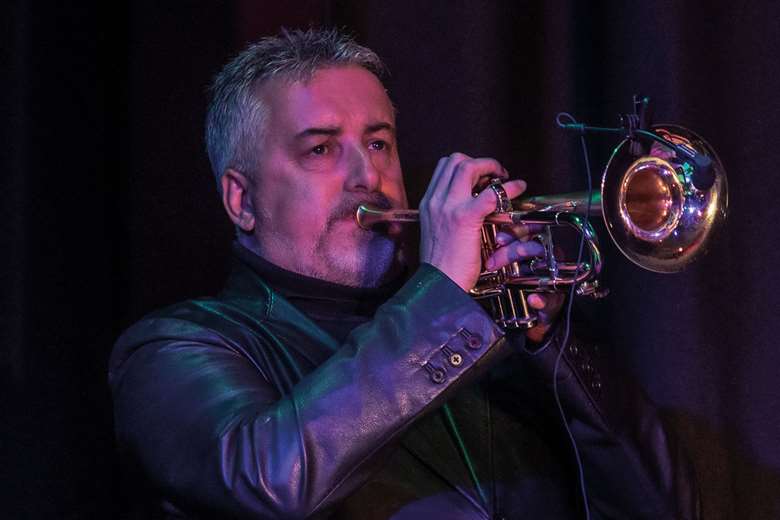Linley Hamilton: The Player
David Gallant
Thursday, June 13, 2024
Trumpeter, broadcaster and co-owner of County Down-based jazz venue Magy’s Farm (see page 13)... Linley Hamilton speaks to David Gallant about his life in music – and his favourite instruments over the years

I think there is something magical about putting a mouthpiece into a trumpet and setting it on your face,” says Linley Hamilton. “Once the connection is made, it is at one with the body – the breathing system, diaphragm, airstream, lips and then the throwing of the air through the instrument and through the bell.
"The instrument, to all intents, becomes part of the body and we are at one as we make the music, project the sound and generate the narrative to what we play: musically, dynamically, emotionally. It’s quite a feeling! It’s personal.”
Hamilton picked up a school trumpet in primary school when he was nine: “It was a learner’s model, but within the first six months of playing I got a Yamaha model, medium bore, which kept me going until I bought my first real trumpet, a Yamaha 8310.
I did a concert with Van Morrison in the 1990s at Belfast City Hall when Bill Clinton was in Belfast to kick-start the Peace Process
"I developed a love for music through school ensembles and brass bands and came to jazz in my mid-teens. I had peripatetic lessons from a teacher named Hugh Megarrell who was very influential; and private lessons from a lead trumpet player called Bob Dawson, who turned me onto the instrument for real.
"I was very busy with not only school bands, but also orchestras and an amateur big band, a brass band, and a small Dixieland band. At the back end of my teens I got into the Irish Youth Jazz Orchestra under the tutelage of Bobby Lamb, and that was an incredible experience.”
I was keen to know who Hamilton was listening to and being influenced by back then.
“Freddie Hubbard – my all-time hero," he answers. "He just had so much going on – the huge range, the fast subdivisions and incredible flexibility, the musical ideas, the individual personal traits he would regularly employ, the infectious personality and the sporadic times he would cross over into other genres like with 'Zanzibar' for Billy Joel. Most influential was his work with Blakey, and his own albums of the 1960s and 70s like Ready for Freddie, Hub Tones and Sky Dive. And I also love Clifford Brown – such a brilliant player and the jazz language he used, easy to understand when transcribing and studying note choices. A very fluid player with lyrical traits as well as technical brilliance.”
Hamilton went on to read Civil Engineering at Queen’s University, Belfast.: “At that stage I had no inkling of a professional career, which didn’t happen until about five years later when jazz became a focus and I toured with The Commitments and other Irish bands.”
We get on to Hamilton’s choice of trumpet: “I picked up that Yamaha 8310 after blowing one in a big band rehearsal in Dublin. It was easier to play than the horn I was playing and a couple of guys in the section had them. I did a load of records, and memorable gigs with that horn: including a concert with Van Morrison in the 1990s at Belfast City Hall when Bill Clinton was in Belfast to kick-start the Peace Process. There were around 200,000 people around the Hall, which has a capacity of abot 500. A profound day all round… After that, I moved onto a second-hand Taylor Chicago Concept II trumpet. I got to meet and talk to Andy Taylor a lot in subsequent years, and in 2010 bought the Taylor Chicago Light, which is my current working trumpet. I followed up with a Taylor ‘Phat Boy’ Flugel in 2016.”
Although Hamilton is still active on all three Taylor horns, his current horn of choice is a Taylor Chicago 46 II VR.
“It’s much lighter than the heavier Chicago I used. It has a direct sound which is so good in sections, but works well for jazz and has helped me to sculpt an individual tone as a soloist in various jazz settings. It’s a medium bore, is free-blowing, and has a fast, quiet valve action.
“I’ve just heard that Andy Taylor is planning to retire at the end of this year. What a career. He experimented, kept pushing the boundaries, testing, finding new solutions, designing original looking and sounding horns that have been played by many of the world’s top players. What a legacy. What a legend.”
We’re onto mouthpieces: “I played a Yamaha Bobby Shew Jazz for years, and eventually got Andy Taylor to customise a mouthpiece based on this for me. It’s a 16.5 mm inner diameter, medium cup and back-bore which services all the playing I do really well.”
Although Hamilton’s music is firmly rooted in post-bop, he is not adverse to employing a pedalboard when the occasion demands.
He elaborates: “I use the pedalboard in certain fusion and pop-solo settings, with a foot pedal which switches between the pre-programmed reverbs on a Pedaltrain Nano board with an MXR Carbon Copy Bright Delay Pedal, MXR Blue Box Distortion, a DB500 passive DI box and a Cry Baby Wah.”
And what of the future? “My life has been at one with the music as I have become its servant and evangelist, and I look forward to continuing to serve the community until my last breath.”








